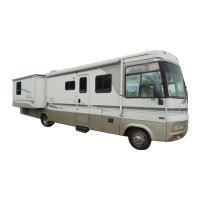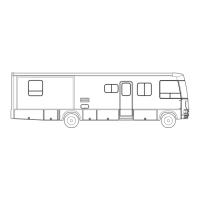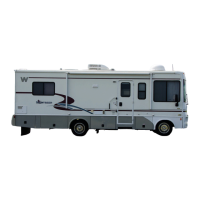Do you have a question about the Winnebago 2003 adventurer and is the answer not in the manual?
Guide to safe operation of features, equipment, and controls in the coach.
Manual from the chassis manufacturer for operating safety and maintenance.
Contains information supplied by manufacturers of individual appliances and equipment.
Recommendations for pre-driving checks and safe operation of the motor home.
Details of the factory warranty against defects in material and workmanship.
Details and meaning of the information on the vehicle certification label.
Explanation of safety terms like Note, Caution, Warning, and Danger.
General safety guidelines for operating the motor home safely.
Precautions and tips for safe operation of the motor home while driving.
Safety precautions related to the fuel and LP gas systems.
Procedure to follow if LP gas leaks are detected.
Information on the LP gas detector and what to do if the alarm sounds.
Safety precautions for handling electrical components and systems.
Guidelines for securely storing items inside the motor home.
Safety precautions related to vehicle maintenance.
Warning about the dangers of carbon monoxide from exhaust gases.
Details about the carbon monoxide alarm system and testing.
Information on emergency exit windows and their operation.
Location and maintenance recommendations for the fire extinguisher.
Information on the smoke alarm, testing, and maintenance.
Recommended procedures to aid in driving safety before entering the vehicle.
Recommended procedures for safe operation before driving the motor home.
Explanation of the single-key system for opening all doors.
Guidance on selecting the proper fuel type for the vehicle.
Instructions for setting and releasing the parking brake.
Information on operating hazard warning lights for emergencies.
Operation of the electric entrance step and its modes.
Instructions for adjusting and swiveling driver and co-pilot seats.
Proper use, care, and importance of lap and three-point seat belts.
Requirements and guidelines for installing and using child restraint systems.
Operation and calibration of the compass and thermometer unit.
Operation of the auto air conditioner and heater system.
How to use the electronic speed control for steady driving.
Information on the optional auxiliary rear coach heater.
Operation of the optional compact disc changer.
Using the switch for emergency starting power from house batteries.
Introduction to the electronic hydraulic leveling system.
Step-by-step instructions for leveling the motor home.
Operation of the slideout living room extension.
How to use hazard flashers for safety when stopped on the roadway.
Procedures and advice for handling sudden tire failure.
Safety precautions and procedures for changing tires.
General safety precautions before changing front or rear tires.
Safety precautions and procedures for changing dual rear wheels.
Importance of proper tightening and checking of wheel nuts.
Safety precautions and steps for jump starting a vehicle.
Detailed instructions for connecting jumper cables safely.
Steps to take if the engine overheats while driving.
Guidelines for distributing cargo weight to avoid exceeding ratings.
Importance of checking and adjusting front suspension alignment.
Information on belted seating positions and cargo carrying capacity.
Guidelines and precautions for towing a car or trailer.
A checklist of essential items to verify before starting a trip.
Useful advice and suggestions for traveling with a motor home.
Information and precautions for dealing with severe weather conditions.
Tips and precautions for driving safely at night.
Techniques and precautions for driving in mountainous or hilly terrain.
Importance and methods of leveling the motor home for comfort and appliance function.
Information on the LP gas system, its safety features, and components.
Key precautions for safe operation and maintenance of the LP gas system.
Guidance on choosing between propane and butane for the LP tank.
Description of the LP tank system, its location, and safety checks.
Procedures and precautions for refilling the LP gas tank.
Regulations and warnings regarding traveling with LP gas tanks.
Information on the LP gas pressure regulator and its maintenance.
Procedures to follow if LP gas leaks are detected.
How LP gas performance is affected by temperature in winter.
Operation of the 110-volt AC system from external sources or generator.
How to connect and use the external power cord safely.
Role of park fuses/breakers in protecting the vehicle's electrical system.
How the EMS manages electrical loads to prevent tripping breakers.
Function of the power center in converting AC to DC power.
Function of GFCI outlets for protection against electrical shock.
How the transfer switch connects power from generator or external source.
Procedures for starting and stopping the onboard generator.
Important warnings and cautions regarding generator operation.
Overview of the chassis and house battery systems.
Location of automotive fuses and circuit breakers under the dash.
Function of the solar panel in maintaining battery charge.
Essential practices for maintaining lead-acid batteries.
Information on the pre-wired trailer connector for lights.
Description of the fresh water system and its supply sources.
Steps for filling the fresh water tank from city water or potable source.
Operation of the water pump switch and recommendations for use.
Steps for the initial start-up of the fresh water system.
How to connect to an external water source and related precautions.
How the water purifier system works and how to replace the filter cartridge.
Features and location of the exterior shower.
Description of the waste water system and holding tanks.
Procedures for safely dumping the black and gray water holding tanks.
How to monitor fresh water and holding tank levels.
Capacities for black and gray water holding tanks for different models.
Location and function of the water system winterization valve.
Steps for filling the water lines with RV antifreeze for winterization.
How to open and close water drain valves for draining the system.
Operation and leveling requirements for the refrigerator.
Importance of proper leveling for refrigerator operation.
How to operate the standard Norcold refrigerator models.
Details on the refrigerator's control panel and auto mode operation.
How the refrigerator selects power sources automatically.
How to manually select operating modes for the refrigerator.
Guidelines for food storage inside the refrigerator for best results.
Recommendations for storing frozen foods and ice making.
Steps for defrosting the refrigerator and freezer.
Operation of the motor home's range and oven.
Instructions for lighting and using the range top burners.
Operating instructions for the microwave oven.
Function and maintenance of the range hood vent.
Overview of the monitor panel for checking utility systems.
How to check water and holding tank levels via the monitor panel.
How to check the voltage of house and engine batteries.
Operation and maintenance of the dual-power water heater.
Specific instructions for operating the water heater on LP gas.
Safety precautions related to gas appliances, especially smelling gas.
Procedures for turning off the water heater for operation or storage.
Location and function of the water heater by-pass valve.
How the motor aid system uses engine heat to warm water.
Start-up and operation instructions for the LP gas furnace.
Operation of the thermostat for heating and cooling systems.
How to set the thermostat for heating mode.
Information on the optional air source heat pump system.
Description of the central air conditioner system and its components.
Location and replacement instructions for the air conditioner filter.
How to raise, rotate, and lower the TV antenna.
Operation of the signal amplifier for the TV antenna.
Location of external connections for telephone and cable TV.
How the satellite TV system works and its setup.
How the inverter converts 12V DC to 110V AC for devices.
Safety precautions regarding sleeping facilities while the vehicle is in motion.
Instructions for converting the couch into a bed and back.
Instructions for converting the dinette into a bed and back.
Operation and cleaning of the fresh water toilet.
Key things not to do with the RV toilet and holding tank.
Operation of the powered roof vent in the bathroom.
How to open and close slider windows.
Using the dual-function window shades for privacy.
General exterior care and maintenance recommendations.
Care and maintenance of the motor home's roof.
How to wash and wax the exterior gelcoat finish.
Regular washing procedures to keep the exterior clean.
Recommended cleaning methods for interior fabrics.
Specific cleaning advice for different upholstery types.
Care and cleaning recommendations for window treatments and bedspreads.
Care and maintenance of plastic laminate surfaces.
How to maintain and clean solid surface countertops.
Cleaning and maintenance for the stainless steel sink.
Cleaning recommendations for the bathroom tub, shower, and lavatory.
Accessing engine components under the hood.
How to open and close the vehicle hood.
Information on checking and refilling engine coolant.
Importance of proper tire inflation and maintenance.
Checking and maintaining all exterior lights for proper operation.
Steps to prepare the vehicle for storage to prevent damage.
Detailed steps for winterizing the motor home's systems.
Steps for installing the antifreeze diverter plug during winterization.
Procedures for winterizing the washer/dryer unit.
Guide to safe operation of features, equipment, and controls in the coach.
Manual from the chassis manufacturer for operating safety and maintenance.
Contains information supplied by manufacturers of individual appliances and equipment.
Recommendations for pre-driving checks and safe operation of the motor home.
Details of the factory warranty against defects in material and workmanship.
Details and meaning of the information on the vehicle certification label.
Explanation of safety terms like Note, Caution, Warning, and Danger.
General safety guidelines for operating the motor home safely.
Precautions and tips for safe operation of the motor home while driving.
Safety precautions related to the fuel and LP gas systems.
Procedure to follow if LP gas leaks are detected.
Information on the LP gas detector and what to do if the alarm sounds.
Safety precautions for handling electrical components and systems.
Guidelines for securely storing items inside the motor home.
Safety precautions related to vehicle maintenance.
Warning about the dangers of carbon monoxide from exhaust gases.
Details about the carbon monoxide alarm system and testing.
Information on emergency exit windows and their operation.
Location and maintenance recommendations for the fire extinguisher.
Information on the smoke alarm, testing, and maintenance.
Recommended procedures to aid in driving safety before entering the vehicle.
Recommended procedures for safe operation before driving the motor home.
Explanation of the single-key system for opening all doors.
Guidance on selecting the proper fuel type for the vehicle.
Instructions for setting and releasing the parking brake.
Information on operating hazard warning lights for emergencies.
Operation of the electric entrance step and its modes.
Instructions for adjusting and swiveling driver and co-pilot seats.
Proper use, care, and importance of lap and three-point seat belts.
Requirements and guidelines for installing and using child restraint systems.
Operation and calibration of the compass and thermometer unit.
Operation of the auto air conditioner and heater system.
How to use the electronic speed control for steady driving.
Information on the optional auxiliary rear coach heater.
Operation of the optional compact disc changer.
Using the switch for emergency starting power from house batteries.
Introduction to the electronic hydraulic leveling system.
Step-by-step instructions for leveling the motor home.
Operation of the slideout living room extension.
How to use hazard flashers for safety when stopped on the roadway.
Procedures and advice for handling sudden tire failure.
Safety precautions and procedures for changing tires.
General safety precautions before changing front or rear tires.
Safety precautions and procedures for changing dual rear wheels.
Importance of proper tightening and checking of wheel nuts.
Safety precautions and steps for jump starting a vehicle.
Detailed instructions for connecting jumper cables safely.
Steps to take if the engine overheats while driving.
Guidelines for distributing cargo weight to avoid exceeding ratings.
Importance of checking and adjusting front suspension alignment.
Information on belted seating positions and cargo carrying capacity.
Guidelines and precautions for towing a car or trailer.
A checklist of essential items to verify before starting a trip.
Useful advice and suggestions for traveling with a motor home.
Information and precautions for dealing with severe weather conditions.
Tips and precautions for driving safely at night.
Techniques and precautions for driving in mountainous or hilly terrain.
Importance and methods of leveling the motor home for comfort and appliance function.
Information on the LP gas system, its safety features, and components.
Key precautions for safe operation and maintenance of the LP gas system.
Guidance on choosing between propane and butane for the LP tank.
Description of the LP tank system, its location, and safety checks.
Procedures and precautions for refilling the LP gas tank.
Regulations and warnings regarding traveling with LP gas tanks.
Information on the LP gas pressure regulator and its maintenance.
Procedures to follow if LP gas leaks are detected.
How LP gas performance is affected by temperature in winter.
Operation of the 110-volt AC system from external sources or generator.
How to connect and use the external power cord safely.
Role of park fuses/breakers in protecting the vehicle's electrical system.
How the EMS manages electrical loads to prevent tripping breakers.
Function of the power center in converting AC to DC power.
Function of GFCI outlets for protection against electrical shock.
How the transfer switch connects power from generator or external source.
Procedures for starting and stopping the onboard generator.
Important warnings and cautions regarding generator operation.
Overview of the chassis and house battery systems.
Location of automotive fuses and circuit breakers under the dash.
Function of the solar panel in maintaining battery charge.
Essential practices for maintaining lead-acid batteries.
Information on the pre-wired trailer connector for lights.
Description of the fresh water system and its supply sources.
Steps for filling the fresh water tank from city water or potable source.
Operation of the water pump switch and recommendations for use.
Steps for the initial start-up of the fresh water system.
How to connect to an external water source and related precautions.
How the water purifier system works and how to replace the filter cartridge.
Features and location of the exterior shower.
Description of the waste water system and holding tanks.
Procedures for safely dumping the black and gray water holding tanks.
How to monitor fresh water and holding tank levels.
Capacities for black and gray water holding tanks for different models.
Location and function of the water system winterization valve.
Steps for filling the water lines with RV antifreeze for winterization.
How to open and close water drain valves for draining the system.
Operation and leveling requirements for the refrigerator.
Importance of proper leveling for refrigerator operation.
How to operate the standard Norcold refrigerator models.
Details on the refrigerator's control panel and auto mode operation.
How the refrigerator selects power sources automatically.
How to manually select operating modes for the refrigerator.
Guidelines for food storage inside the refrigerator for best results.
Recommendations for storing frozen foods and ice making.
Steps for defrosting the refrigerator and freezer.
Operation of the motor home's range and oven.
Instructions for lighting and using the range top burners.
Operating instructions for the microwave oven.
Function and maintenance of the range hood vent.
Overview of the monitor panel for checking utility systems.
How to check water and holding tank levels via the monitor panel.
How to check the voltage of house and engine batteries.
Operation and maintenance of the dual-power water heater.
Specific instructions for operating the water heater on LP gas.
Safety precautions related to gas appliances, especially smelling gas.
Procedures for turning off the water heater for operation or storage.
Location and function of the water heater by-pass valve.
How the motor aid system uses engine heat to warm water.
Start-up and operation instructions for the LP gas furnace.
Operation of the thermostat for heating and cooling systems.
How to set the thermostat for heating mode.
Information on the optional air source heat pump system.
Description of the central air conditioner system and its components.
Location and replacement instructions for the air conditioner filter.
How to raise, rotate, and lower the TV antenna.
Operation of the signal amplifier for the TV antenna.
Location of external connections for telephone and cable TV.
How the satellite TV system works and its setup.
How the inverter converts 12V DC to 110V AC for devices.
Safety precautions regarding sleeping facilities while the vehicle is in motion.
Instructions for converting the couch into a bed and back.
Instructions for converting the dinette into a bed and back.
Operation and cleaning of the fresh water toilet.
Key things not to do with the RV toilet and holding tank.
Operation of the powered roof vent in the bathroom.
How to open and close slider windows.
Using the dual-function window shades for privacy.
General exterior care and maintenance recommendations.
Care and maintenance of the motor home's roof.
How to wash and wax the exterior gelcoat finish.
Regular washing procedures to keep the exterior clean.
Recommended cleaning methods for interior fabrics.
Specific cleaning advice for different upholstery types.
Care and cleaning recommendations for window treatments and bedspreads.
Care and maintenance of plastic laminate surfaces.
How to maintain and clean solid surface countertops.
Cleaning and maintenance for the stainless steel sink.
Cleaning recommendations for the bathroom tub, shower, and lavatory.
Accessing engine components under the hood.
How to open and close the vehicle hood.
Information on checking and refilling engine coolant.
Importance of proper tire inflation and maintenance.
Checking and maintaining all exterior lights for proper operation.
Steps to prepare the vehicle for storage to prevent damage.
Detailed steps for winterizing the motor home's systems.
Steps for installing the antifreeze diverter plug during winterization.
Procedures for winterizing the washer/dryer unit.
| Manufacturer | Winnebago |
|---|---|
| Year | 2003 |
| Model | Adventurer |
| Fuel Type | Gasoline |
| Transmission | Automatic |
| Fuel Capacity | 75 gallons |
| Generator | Onan |
| Category | Motorhome |
| Sleeps | 6 |
| Sleeping Capacity | 6 |












